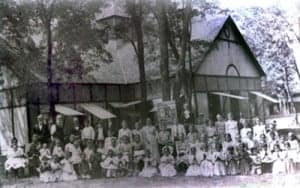(This article is continued from The History of Franklin Township, Part 1.)
Part 2: Acton
We’ve mentioned New Bethel; the other town in Franklin Township, now known as Acton, was not laid out until 1852. In its early years, Acton was originally known as Farmersville. Much like New Bethel, the town was renamed in 1854 when the U.S. Postal Service discovered there was already a town named Farmersville in Posey County, Indiana. There is some debate over the source of the new name, though some have postulated that it was chosen in honor of an early settler, General Acton.
Acton got a later start than New Bethel/Wanamaker, but rapidly grew into a larger, more successful town. This was in large part due to the railroad, which ran through the town. During its heyday Acton was large enough to support three lodge halls, multiple grocery stores, blacksmith and wagon shops, and a telegraph operator, among other things.
But Acton’s biggest claim to fame was something that wasn’t even in the town itself: The 40-acre Acton Campground existed from 1859 to 1905 and drew tens of thousands of visitors. Five trains a day stopped at the Campground, in addition to the interurban (the extensive light rail system that provided public transit throughout central Indiana from the 1890s until 1941). The Campground, created primarily for religious camp meetings but also offering other entertainments, had more than a hundred cottages, a pavilion, a two-story hotel, and a man-made lake where campers could boat or bathe. During the Civil War, it was briefly used as a hospital facility for wounded soldiers (until the campground facilities were destroyed by dissenters), but returned to its primary function of recreation and camp meetings in 1865.
The 1870s through the 1920s was the era of the Chautauqua movement, a highly popular adult education movement named after Chautauqua Lake, NY, where the first event was held in 1874. Chautauqua assemblies spread throughout rural America, and “brought entertainment and culture for the whole community, with speakers, teachers, musicians, entertainers, preachers and specialists of the day” — valuable commodities in an era prior to the invention of radio and television. An 1878 newspaper article described a day at the campground on August 4 of that year: “There were fully ten thousand people on the grounds, and there were no disturbances.”
Acton Campground, later known as Acton Park, hosted these Chautauqua assemblies. “The crowds sometimes numbered in the thousands. They heard clergymen, temperance leaders, evangelists and politicians. Presidential candidate, member of the House of Representatives and Secretary of State William Jennings Bryan spoke there several times. At Chautauqua Assemblies in 1904 and 1905, there were stereoptican programs, elocutionists, bands and orchestras, singing groups, sermons and book reviews, among other things.” There was also a bandstand on the grounds, and doubtless people spread out on the lawns to hear the music.
But 1905 was to be the last year for the Acton Campground. On November 12 of that year, two little girls playing near the campground saw fire in the dry leaves near the train tracks after an afternoon freight train had passed by. They alerted others and the Acton townspeople tried to put out the fire, but in just half an hour every one of the 110 cottages was ablaze, and by an hour later all the cottages and the Pavilion had burned to the ground and 425 trees were destroyed. (In 1980, FTHS president emerita Sylvia Henricks interviewed one of the girls who had seen the fire start, by then 92 years old.)
About half of the original Campground property is now being made into a city-county park. There is a historical marker about the Acton Campground near the park entrance, on the north side of Southport Road immediately west of Acton Road.
Another of Acton’s claims to fame is as the birthplace of actress Marjorie Main, who was born on the outskirts of the town on February 24, 1890. She was born Mary Tomlinson, but when she decided to pursue an acting career she changed her name to Marjorie Main to prevent any embarrassment to her family. After a successful stint on Broadway, she went on to appear in nearly 90 films. She is best known for her role as “Ma” in the Ma and Pa Kettle movies, but she also appeared in films with Humphrey Bogart, John Wayne, Lucille Ball, Roy Rogers, Claudette Colbert, William Powell, Gene Kelly, and many other top stars. She was nominated for an Academy Award in 1948 and for a Golden Globe in 1957.


We live on the farm property at 7220 S. Franklin Road (formerly the Bangle farm). We want to re-purpose one of the barns for an event center. Do you have any background information that would be helpful in making our case for preserving this piece of Franklin Township history?
We would be happy to help you research your property! Please stop by our Meeting House during Open Hours (the first Saturday and third Sunday of each month from 1 to 4 p.m.).
I have been trying to find out more about my Grandmother and her family. She was born Sophia Christina Kraut/Krout, in Wannamaker/New Bethel in 1883. Her maternal grandparents surname was Linlow/Linlau. I have some very old school pictures that may be from that area. One is dated 1876. Is there some way to send it via email ? Would love to know if that school was in that area.
My family lives in Brazil Indiana about 45 minutes west of Indianapolis. I never knew Marjorie Main was born in the area. Can you give me a list of celebrities that were born in Indiana. I would appreciate it very much.
Majorie Main was born in her grandfather’s house on Dix Rd which btw still stands.
As for Indiana celebrities, John Mellencamp and Joyce DeWitt come to mind.